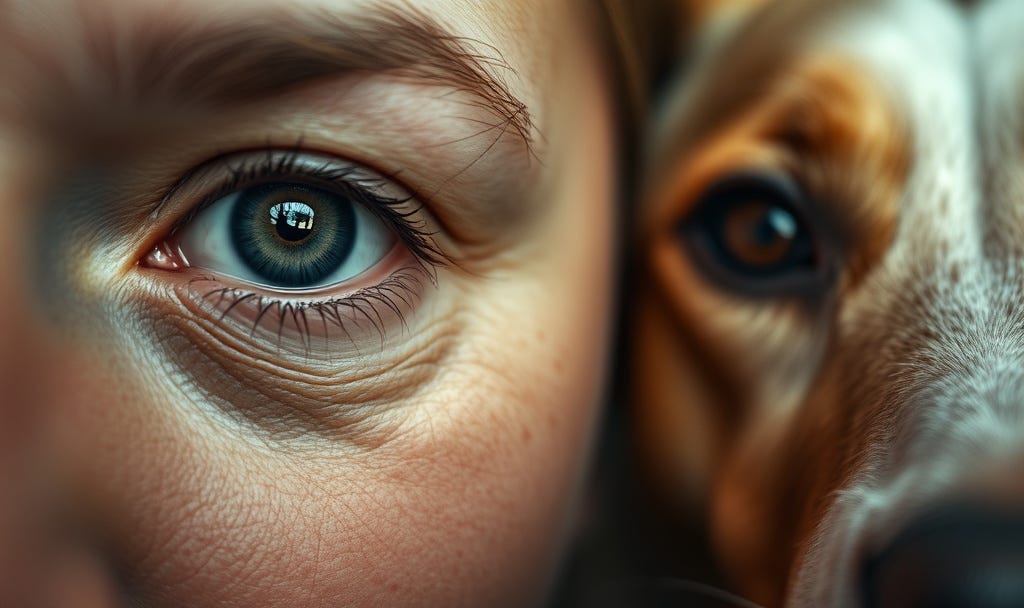Is the Human–Dog Bond the Antidote to Modern Loneliness?
A quiet essay on belonging, from a 14,000-year-old grave to your next meeting

I lost Sam on a Tuesday in 2003.
He was a rescue mutt, part American Eskimo, part mystery, all heart. He’d greet me at the door after 12-hour shifts and long Navy deployments like I’d been gone a decade. That night, as the vet walked away, I sat on the linoleum floor, his head heavy in my lap, and whispered, “Who am I without you seeing me?”
The human-dog bond, our oldest emotional firewall, shut down that day.
Twenty-two years later, in a world of silent Slacks and camera-off Zooms, that question haunts me more than ever. We chase productivity hacks and AI sidekicks, but we’ve unplugged the one system that made us human: connection. Not the performative kind, the original kind, etched in bone and synapse.
This isn’t abstract philosophy. It’s archaeology, evolutionary biology, and a quiet plea from every dog who’s ever leaned into your leg. Let’s trace it back, then build forward. Together.
Revolution 1: The Co-Evolution Contract
14,000 years ago, in a gravel pit near Bonn, Germany, a seven-month-old puppy was buried beside two humans. Milk teeth intact, bones dusted with red ochre, antler tools tucked alongside like heirlooms.
This wasn’t a pet’s grave. It was the first human-dog bond, a pact sealed in ochre and eternity. Archaeologists at the Max Planck Institute call it the oldest evidence of humans and dogs sharing eternity, not as master and tool, but as mutual guardians. “I’ll protect you,” the ochre seems to say, “if you help me feel less alone.”
Fast-forward. Geneticists sequenced 700 ancient dog genomes last year. Verdict? Dogs didn’t just adapt to us. They chose us. A mutation in their facial genes softened ears, widened eyes, and turned snarls into invitations. Paedomorphosis, the evolutionary trick that keeps a 70-pound shepherd looking like an eternal pup.
Our side of the contract? Oxytocin receptors lit up like Christmas. A 2015 Science study found 30 minutes of mutual gaze spikes the “cuddle hormone” in humans by 300 percent, mirroring a mother’s bond with her infant.
Dogs became our external emotional regulators. Healed fractures in Neolithic sites prove it: we carried them through arthritis and fed them past wild lifespans. They tamed our chaos. We softened their wild.
And that’s Revolution 3, the accidental famine we’re designing today.
Revolution 2: The Human-Dog Bond & Empathy Inheritance
In 1872, Charles Darwin steals a biscuit, watches his dog feign guilt, and pens The Expression of the Emotions in Man and Animals. That “guilty look” is older than agriculture and the wheel.
It’s mirror neurons at work, the human-dog bond in real time, firing across species since the Pleistocene. Discovered in the 1990s, macaques don’t discriminate. Your brain lights up predicting a tail wag the same way it does a friend’s smile. A 2021 PNAS study found that a dog’s 1–5 Hz wag syncs your heart rate in seven seconds. I see you. I am you.
Elias Friedman,
, has captured 60,000 pups on Manhattan streets. His secret? The 3-Second Pause. Crouch. Hold eye contact until the dog breaks it. Ears flick from “threat?” to “we’re good.” Tail thumps. The empathy door cracks.Why three seconds? Street truth, not a lab stopwatch. Behavioral science nods: dogs assess in under five. Translate to us: Next barista run, add a name and micro-truth. “Jay, that foam art slayed last week. Encore?”
One hit sparks curiosity. Seven in a week builds attachment.
Skip them?
A 2023 meta-analysis in Nature Human Behaviour and related research highlights that missing regular micro-moments of social connection can significantly increase stress levels, as reflected in elevated cortisol levels, and impair creativity and cognitive function. Hybrid workers who hear their name fewer than 3 times a day report 79% more exhaustion (Gallup, 2025).
Headphones become walls. Black-box Zooms like tombstones. We’ve hacked the inheritance.
Revolution 3: The Invisible Balance Sheet
In 2022, Maya Patel, a mid-level engineer at Shopify, ran the numbers on her life.
Salary: competitive.
Equity: vesting.
Sleep: 5.8 hours.
Slack pings after 6 p.m.: 41.
She hadn’t missed a deadline in five years, and her performance reviews were glowing. Yet every morning, she woke up with a knot in her stomach the size of a fist.
The problem? It wasn’t the work. It was the silence.
Slack channels went dark right at 5:01 p.m. Her manager’s feedback was a thumbs-up emoji, and new hires got a Notion doc and a “Welcome!” GIF for onboarding. Exciting, right?
Maya’s breaking point came during a retro when the facilitator asked, “What drained you this week?” The room was so quiet you could hear a pin drop. No one spoke.
Then came a radical pivot, courtesy of
. Executive coach, burnout survivor, and woman who nearly died racing the hustle, she suggested shaking things up.From day one, onboarding wasn’t about code. It was about three slides:
A childhood photo
A personal mantra
A burning question for the team
Maya’s slide? A Polaroid of her eight-year-old self holding a rescue mutt named Pickles. Her mantra? “Done is better than perfect.” Her question? “Who here has ever felt invisible at work?”
Every hand went up.
Ninety days later, psychological safety scores shot up 38 percent, voluntary turnover dropped 22 percent, and Maya stayed for good.
“It wasn’t the slides,” she told me. “It was the permission to be human.”
The 90-Second Tribe Builder
The counter-revolution is deceptively small. Amina Altai calls it the Three R’s. Total cost: ninety seconds.
R1: Regulate
Start every meeting with a single sentence that names your energy level.
“I’m at sixty percent today—rough commute.”
Eight seconds. Armor down. Empathy in.
R2: Reveal
Drop one human detail.
“My dog ate my AirPod. Again.”
Room exhales. Permission granted.
R3: Reinforce
End every one-on-one with:
“One thing I appreciate about working with you is…”
Ten seconds. Week shifted.
Ninety seconds total. A tribe that has your back—even when the camera’s off.
The Counter-Revolution
The bond we share with dogs is more than history or biology. It’s the blueprint of human connection itself. For 14,000 years, these quiet companions have helped us remember what it means to matter, to be seen, to belong. Yet today, in a world dominated by muted Slack and blank Zoom screens, we’ve drifted from that essential system.
Connection isn’t found in productivity hacks or AI assistants. It’s found in micro-moments, a shared gaze, a name spoken, a glimpse of vulnerability. Science shows us these moments ignite ancient circuits wired for belonging. The human-dog bond is more than history or biology. It’s a powerful emotional system shown to alleviate loneliness and improve well-being across cultures and ages (Stanley et al., 2022)
The revolution we need is low-tech. A pause instead of another ping. A check-in with a real person, not a status update. A simple ritual to remind us: we are not alone.
So today, start small. Take ninety seconds to regulate, reveal, and reinforce. Name your energy. Share a human crumb. Send a genuine “I appreciate you.” In this quiet act, you reboot the original operating system still running inside us.
It’s a revolution of presence, a ripple that starts not with a roar but with the soft thump of a tail at 2.8 seconds.
The revolution renews with one gaze. One name. One, “I noticed.”
You’re seen. You matter. Let’s build the pack.
Pass It Forward
This essay echoes my new children’s book, You Matter, Luma—a tiny bunny who feels invisible until her kindness ripples out, changing everything. It’s for every kid (and adult) whispering Max’s question: Who am I if unseen?
Preorder now at Barnes & Noble or Bookshop.org. Your support spreads the mattering to families everywhere.
👉 Get the Connection Compass workbook here—reflection prompts, science exercises, team starters.
👉 Listen to episode 690 of Passion Struck, ad-free:
P.S. If this stirred your original OS, forward it to one soul who needs it. Ripples start here.
References and Further Reading
Stanley, I., et al. (2022). The Human-Dog Bond as a Mediator in Loneliness and Emotional Well-Being. Human-Animal Interaction Bulletin. [Link]
McConnell, A.R., et al. (2011). Social Needs Fulfillment by Pets and Subjective Happiness. J. Pers. Soc. Psychol. [Link]
Herzog, H. (2011). The Emotional Lives of Companion Animals. [Link]
Additional studies from NIH, Nature Human Behaviour, Frontiers in Psychology...




